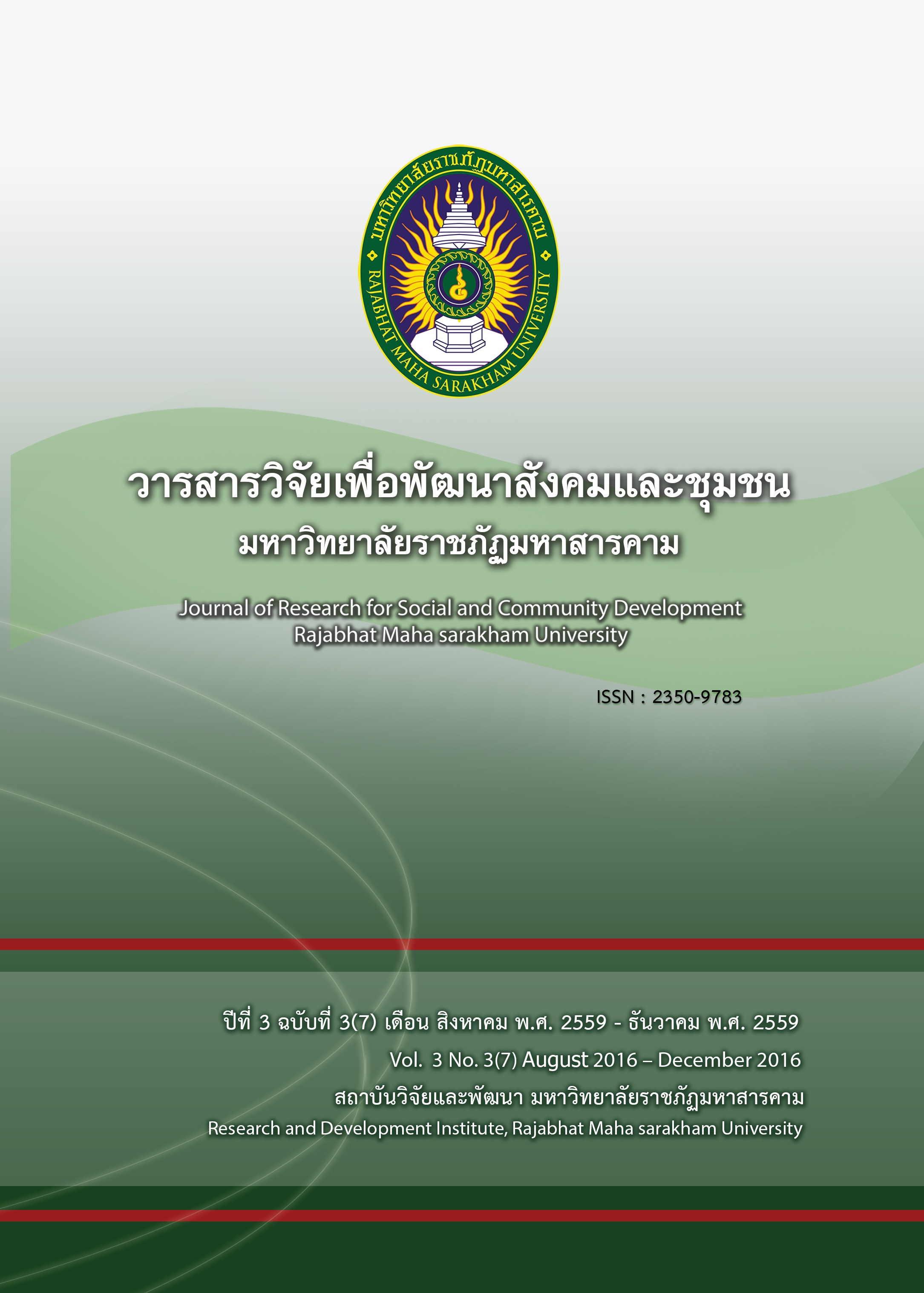การศึกษาธาตุอาหารในปุ๋ยที่ได้จากการใช้ไส้เดือนย่อยสลายเศษวตัถุดิบ
คำสำคัญ:
ไส้เดือน (สายพันธุ์ E. eugeniae และสายพันธุ์ P. peguana) เศษวัตถุดิบ ปุ๋ยมูลไส้เดือนบทคัดย่อ
การวิจัยครั้งนี้มีวัตถุประสงค์เพื่อศึกษาปริมาณธาตุอาหาร ได้แก่ ไนโตรเจน ฟอสฟอรัส โพแต สเซียม แมกนีเซียม และแคลเซียม และศึกษาสมบัติทางเคมี ได้แก่ ความเป็นกรด-ด่าง ค่าการน าไฟฟ้า จากการเลี้ยงไส้เดือนสายพันธุ์ต่างกันในปุ๋ยมูลไส้เดือน และใช้เศษวัตถุดิบต่างกัน โดยใช้แผนการทดลอง แบบ 2x3 Factorial ในแผนการทดลองแบบสุ่มสมบูรณ์ จ านวน 3 ซ้ า ปัจจัยที่ 1 ได้แก่ ไส้เดือน 2 สาย พันธุ์ ได้แก่ E. eugeniae และ P. peguana และปัจจัยที่ 2 ได้แก่ เศษวัตถุดิบ 3 ชนิด ได้แก่ เปลือก แตงโม เศษผักกาดขาว และมูลวัวแห้ง ท าการทดลองระยะเวลา 2 เดือน ผลการศึกษา พบว่า มีอิทธิพลร่วมระหว่างสายพันธุ์ไส้เดือนกับเศษวัตถุดิบต่อการมีปริมาณธาตุ ไนโตรเจน โพแตสเซียม แคลเซียม และแมกนีเซียม และต่อค่าการน าไฟฟ้า (p<.05) แต่ไม่มีอิทธิพลร่วม ระหว่างปัจจัยทั้งสองต่อการมีปริมาณธาตุฟอสฟอรัส และต่อค่าความเป็นกรด-ด่าง (p>.05) โดยส่วน ใหญ่ พบว่า ชุดการทดลองที่ 1 (ไส้เดือน E. eugeniae เลี้ยงด้วยเปลือกแตงโม) มีปริมาณธาตุอาหาร คา่ ความเป็นกรด-ด่าง และค่าการน าไฟฟ้าดีกว่าชุดการทดลองอื่นๆ
References
ภาวนา สิกขานนท์. (2542). ปุ๋ยหมักและขบวนการเป็นปุ๋ยหมักในปยุ๋หมักชีวภาพ. กรุงเทพฯ : กรม วิชาการ เกษตร, กองปฐพีวิทยา, กลุ่มวิจัยจลุินทรียด์ิน.
รินภา เส็งสาย และอรพรรณ ไวแพน. (2551). การสกดัซลิิกาจากขี้เถ้าชานอ้อย. สาขาวิชาฟิสิกส์ วิทยาศาสตร์และเทคโนโลยี มหาวทิยาลัยราชภัฎมหาสารคาม
ศรีสม สุวรรณวงศ์. (ม.ป.ป). การวเิคราะห์ธาตุอาหารพืช. กรุงเทพฯ : มหาวิทยาลัยเกษตรศาสตร์
อัมพร วัฒนชัยเสรีกลุ. (2545). การผลิตปุ๋ยหมักชีวภาพโดยใช้ไสเ้ดอืนดิน. วิทยานิพนธ์ วท.ม. เชียงใหม่ : มหาวิทยาลัยแม่โจ้.
อานัฐ ตันโช. (2548). เทคนิคการผลิตปุ๋ยมลูไส้เดือนดิน. ปทุมธานี : ส านักงานพัฒนาวิทยาศาสตร์ และ เทคโนโลยีแห่งชาติ.
อานัฐ ตันโช. (2550). ไส้เดือนดิน. ปทุมธานี : ส านักงานพัฒนาวิทยาศาสตร์และเทคโนโลยีแห่งชาติ.
Anonymous. (1992). “Recycling of crop residue in the soil and its effect on the performance of rakisorgum, 29th Meeting of Research Review Committee”. Report Agricultural Chemistry and Soil Science., Mahatma Phule Krishi Vidyapeeth (MPKV), Rahuri, India.
Deepika, S. and Surindra, S. (2012). “Vermicomposting of herbal pharmaceutical industry solid wastes”. Ecological Engineering. 36, 1-6.
Edwards et al.. (1972). Biology of earthworms. Chapman and Hall, London.
Edwards, C.A. and Bohlen, P.J.. (1996). Biology of earthworm, third ed. Chapman and Hall. New York/London.
Gaur, A.C. and Singh, G. (1995). “Recycling of rural and urban waste through conventional and vermicomposting. In: Tondon, H.L.S. (Ed.), Recycling of Crop, Animal, Human and Industrial Waste in Agriculture”. Fertilizer Development and Consultation Organization. 31-49.
Kaviraj and Sharma, S.. (2003). “Municipal solid waste management through vermicomposting employting exotic and local species of earthworm”. Bioresour Technol. 90,169-173.
Krisnamoorthy, R.V.. (1990). “Mineralization of phosphorus by faecal phosphatases of some earthworms of Indian tropic”. Proceedings: Animal Sciences. 99 (6), 509518.
Nuhaa, S. et al.. (2015). “Recovery of nutrient from municipal solid waste by composting and vermicomposting using earthworm Eudrilus eugeniae”. Journal of Environmental Chemical Engineering. 3 (4), 2931-2942.
Padmavathiamma, P. K. et al.. (2008). “An experimental study of vermi- biowaste composting for agricultural soil improvement”. Bioresource Technology. 99 (6), 1672–1681.
Sangwan, P. et al.. (2008). “Vermiconversion of industrial sludge for recycling the nutrients”. Bioresource Technology. 99, 8699-8704.
Sharma, S. et al. (2005). “Potentiality of earthworms for waste management and in other Uses – A Review”. The Journal of American Science. 1 (1), 4-16.
Suthar, S. and Singh, S.. (2008). “Vermicomposting of domestic waste by using two epigeic earthworms (Perionyx excavatus and Perionyx sansibaricus) ”. International Journal of Environment Science and Technology. 5 (1), 99–106.
Suthar, S.. (2008). “Bioremediation of aerobically treated distillery sludge mixed with cow dung by using an epigeic earthworm Eisenia fetida”. The Environmentalist. 28 (2), 76–84.
Yadav, A. and Garg, V. K. (2013). “Nutrient Recycling from Industrial Solid Wastes and Weeds by Vermiprocessing Using Earthworms”. Pedosphere. 23 (5), 668–677.
Downloads
เผยแพร่แล้ว
How to Cite
ฉบับ
บท
License
Copyright (c) 2016 สงวนลิขสิทธิ์ 2561 สถาบันวิจัยและพัฒนา มหาวิทยาลัยราชภัฏมหาสารคาม

This work is licensed under a Creative Commons Attribution-NonCommercial-NoDerivatives 4.0 International License.
บทความที่ได้รับการตีพิมพ์เป็นลิขสิทธิ์เป็นของผู้ประพันธ์บทความ






